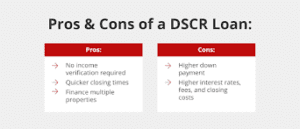dscr loan pros and cons are a popular kind of finance used in business and real estate lending. Its goal is to check if the borrower can make enough money to pay off their debts. This is a quick overview of DSCR loans:
Lenders analyze a borrower’s ability to repay a dscr loan pros and cons by comparing the borrower’s income to the loan payments. One important statistic employed in this analysis is the debt service coverage ratio (DSCR). It is computed by dividing the borrower’s whole debt service (principal, interest, taxes, and insurance) by their net operating income, which is their income after operational expenses are subtracted.
dscr loan pros and cons in 2024: Complete review

A debt service coverage ratio (DSCR) loan is commonly referred to as a “DSCR loan”. Lenders utilize the Debt Service Coverage Ratio, a financial sign, to decide if a borrower can pay off their debts with their income.
- A DSCR loan is designed to guarantee that the borrower’s income will be enough to pay back the loan’s debt. Before approving a loan, lenders usually need to see a minimal DSCR since it shows that the borrower can make enough money to pay off their debts.
The formula for calculating DSCR is:
DSCR = {Net Operating Income} / {Total Debt Service}
Where:
- The money produced by the property after running expenses are subtracted is known as net operating income (NOI).
- Total Debt Service includes principal, interest, taxes, insurance, and all other payments associated with debt.
Pros of DSCR Loans
In commercial and real estate finance, debt service coverage rate (DSCR) loans have the following benefits:

1. Danger Protection: By guaranteeing that borrowers have a consistent source of income to meet their debt commitments, dscr loan pros and cons help banks reduce risk. By doing this, the lender’s chances of default and loss are decreased.
2. Designed Payment: Repayment plans for DSCR loans are usually structured to correspond with the borrower’s ability to generate income. Borrowers may manage their loan payments more easily as a result, and the likelihood of financial distress is decreased.
3. Beneficial Loan Conditions: Borrowers with high DSCR ratios often receive better loan conditions, such longer payback terms or cheaper interest rates. the loan’s life, this may save money.
4. Customizable Financing: DSCR loans are available for a number of uses, such as financing company growth, buying real estate, and refinancing current debt. Because of this flexibility, borrowers can satisfy their unique financial requirements.
5. Asset-Based Loans: When it comes to real estate financing, DSCR loans tend to be asset-based, which means that the lender looks at the property’s ability to generate revenue rather than just the borrower’s credit. Borrowers with good investment properties but less desirable credit histories may benefit from this.
6. Flexibility: A business or real estate portfolio can grow and be supported by the framework of DSCR loans. Borrowers may be eligible for bigger loans or more funding to help with growth plans as their income rises.
7. Stability and Predictability: DSCR loans offer a consistent and predictable financing alternative because they are dependent on the borrower’s income and expenses. By predicting their cash flow and making appropriate financial plans, borrowers can lower their uncertainty.
dscr loan pros and cons are a well-liked option for funding real estate and business projects since they provide a number of advantages to both lenders and borrowers.
Cons of DSCR Loans
While DSCR (Debt Service Coverage Ratio) loans offer several advantages, there are also some drawbacks or cons associated with them:

1. Strict Qualification Requirements: Borrowers seeking DSCR loans often have to fulfill strict qualification requirements, which may include minimum DSCR levels. Some borrowers may find it difficult to qualify for financing as a result, especially those with lower incomes or credit histories.
2. Limited Flexibility: Borrowers may find it challenging to modify their payment amounts or schedules in response to shifting financial conditions because of the rigid repayment plans of DSCR loans.
3. Higher Interest Rates: DSCR loan interest rates may be higher for borrowers with lower DSCR ratios or higher perceived risk. This may result in higher borrowing costs and lower total loan affordability.
4. Asset-Based Security: DSCR loans are asset-based loans in real estate financing since they tend to be secured by the underlying property. This means that borrowers have the possibility of giving up their belongings in the event that they don’t make loan payments, which may be a big drawback if they run into financial trouble.
5. Limited Use: Not all forms of financial needs may be suitable candidates for DSCR loans. because their primary focus is on long-term debt servicing ability, they might not be the best option for short-term or temporary cash flow problems.
6. Level of Complexity: For borrowers who are unfamiliar with financial analysis, calculating and knowing DSCR ratios might be challenging. Borrowers may find it difficult to effectively evaluate and understand their borrowing capability due to this depth.
7. Marketplace reliance: Depending on the state of the market, variables like corporate revenue and rental income might have an impact on DSCR ratios. When there are market disruptions or economic downturns, borrowers may find it difficult to maintain a constant DSCR ratio.
8. Prepayment Penalties: Borrowers who choose to pay off their loans early may be subject to additional fees on certain DSCR loans. This may reduce the options available to borrowers for repayment or refinancing.
Ultimately, even though dscr loan pros and cons have a lot to offer, borrowers should carefully weigh the potential disadvantages and determine whether this kind of financing fits with their financial objectives and capacity.
How do you determine if a DSCR loan is right for you?

1. revenue Stability: Evaluate how steady and predictable your sources of revenue are. Borrowers that have consistent income from sources like businesses, rental properties, or continuous jobs are the best candidates for DSCR loans.
2. Compute Your DSCR: By dividing your net operating income (revenue after expenses) by the total debt service (principal, interest, taxes, and insurance), you may find your current Debt Service Coverage Ratio. If your debt-to-income ratio is 1 or greater, you make enough money to pay off your debts.
3. Risk Tolerance: Evaluate how comfortable you are with danger. Collateral for DSCR loans usually consists of property or other assets that could be seized in the event of a loan default. Determine if you can afford to take on this amount of risk.
4. Financing Requirements: Think about the reasons you are looking for funding. Long-term investments like buying rental properties or financing business expansion are common uses for DSCR loans. A different kind of loan might be more appropriate if you need money right away or if you need greater repayment flexibility.
5. Loan Terms and Conditions: Carefully go over the DSCR loan’s terms and conditions, taking note of interest rates, repayment plans, costs, and any early payment penalties. Make sure that the terms of the loan correspond with your financial objectives and capacity.
6. Consult financial consultants: Ask accountants, financial consultants, and other experts for advice that is customized to your particular circumstances. They can assist you in investigating other financing choices and weighing the possible advantages and disadvantages of a DSCR loan.
7. Take Market Conditions into Account: Assess the economic and market trends that could affect your capacity to sustain a steady DSCR ratio in the long run. Consider the possibility of variations in rental income, sales from your business, or income from other sources.
FAQs
1. The Debt Service Coverage Ratio (DSCR): What is it?
- Lenders use a financial indicator called a debt-to-income ratio, or DSCR, to evaluate a borrower’s capacity to pay off debt. It is computed by dividing the borrower’s total debt service by net operational income.
2. How does lending use the DSCR ratio?
- The DSCR ratio is a tool used by lenders to assess the risk involved in making a loan. Given that a greater DSCR ratio implies that the borrower’s income is adequate to meet debt payments, it lowers the lender’s risk.
3. What DSCR ratio is deemed appropriate?
- Lenders typically view a DSCR ratio of 1.2 to 1.25 or higher as favorable. This provides a margin of safety since the borrower’s income is 1.2 to 1.25 times what is required to pay off their debt.
4. Which loans make use of DSCR analysis?
- In commercial real estate finance, where the revenue produced by the property is essential for debt servicing, DSCR analysis is frequently employed. Additionally, company loans are made using it, especially those that are backed by operating cash flows.
5. How can my ratio of DSCR be improved?
- By boosting their net operating income through tactics including raising rental revenue, cutting costs, or enhancing operational effectiveness, borrowers can raise their DSCR ratio. By refinancing debt at a lower interest rate or extending repayment terms, they can also lessen their overall debt service.
Conclusion
In conclusion, borrowers should carefully consider the benefits and drawbacks of DSCR (Debt Service Coverage Ratio) loans before determining whether this kind of financing is right for them.
- Positively, DSCR loans reduce risk for lenders by offering a standardized method of evaluating a borrower’s capacity to repay their debt.
- For borrowers with high DSCR ratios, they frequently have advantageous loan arrangements, such as extended payback terms and reduced interest rates. dscr loan pros and cons can help with operational scalability and provide flexibility in funding a range of real estate and company endeavors.
- They also offer consistency and predictability in repayment, which helps borrowers make wise financial plans.
There are disadvantages as well. Certain borrowers may find it difficult to meet the qualification requirements for dscr loan pros and cons due to their strict guidelines. There might not be much flexibility in the structured repayment plans, and interest rates might go up for borrowers with lower DSCR ratios.
Due to the fact that these loans are frequently collateralized, borrowers run the danger of losing their possessions in the event of failure. The borrower’s capacity to maintain a stable dscr loan pros and cons may be impacted by market movements that undermine income stability and complicate the computation and interpretation of DSCR ratios. The borrower’s long-term objectives, risk tolerance, and financial status all influence whether a DSCR loan is appropriate. Borrowers can decide if DSCR financing fits their requirements and goals by carefully weighing the benefits and drawbacks and consulting a specialist.

